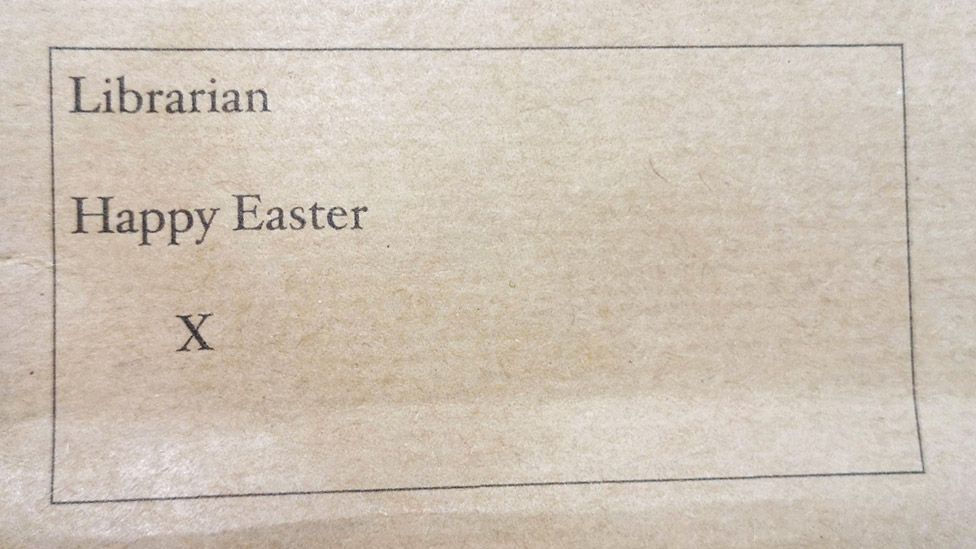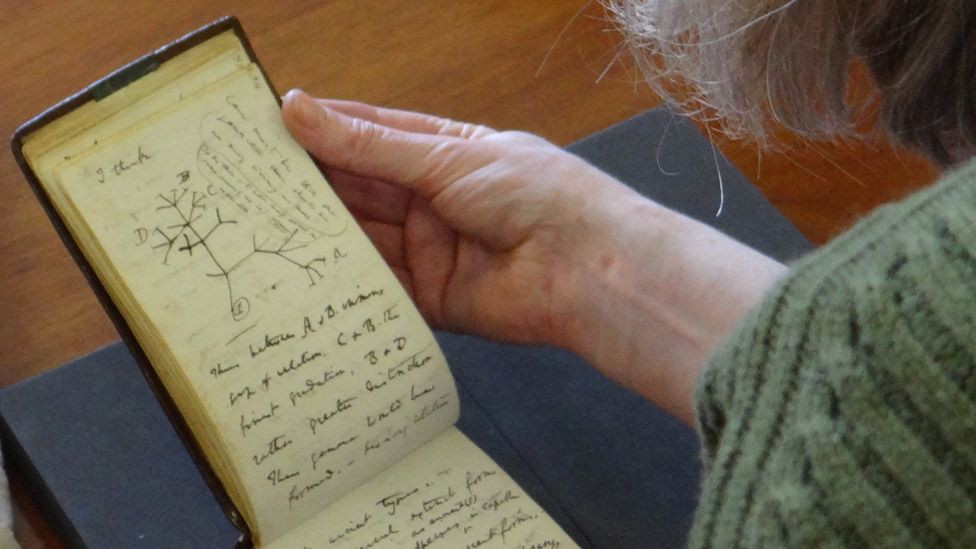John van Wyhe is a historian of science at the University of Singapore, specializing in Darwin and Wallace. Beside his many books he’s known for creating the ultimate Darwin source: Darwin Online, with all of CD’s manuscripts, publications, biographical data—everything but his correspondence, which you can find at Cambridge’s Darwin Correspondence Project. van Wyhe is also known for research that dispelled two persistent myths about Darwin: that he delayed publishing On the Origin of Species because of his fear of public reaction, and that he delayed telling people about A. R. Wallace’s 1858 letter detailing Wallace’s independent discovery of evolution via natural selection—supposedly because Darwin wanted to withhold credit from Wallace (van Wyhe debunked this by tracing the mailboats on which the letter would have traveled.) Both of those claims are bunk but are still repeated, especially by creationists and Darwin-bashers.
van Wyhe’s own bio is online at the site; and about two days ago, just in time for Darwin Day, he announced the creation of a page that brings together in one place every known photograph of Darwin (there aren’t many, but there are some I hadn’t seen). Here’s van Wyhe’s announcement on FB:
If you click on the headline below, you’ll go to the page, and take a few minutes to peruse the Great Man’s visage on his birthday. John’s site is a goldmine for teachers preparing lectures on Darwin and evolution, an the captions of the photos (which I’ve truncated) and all the variants show meticulous scholarship.
I’ll put up a few photos from the page in chronological order; indented captions are by van Wyhe. A few bits from the introductory section:
This is by far the most complete and accurate catalogue of photographs of Darwin ever published. It includes a dozen discovered during the many years of research for this study. The list includes more details about each photograph than previously published, such as dates, prices, the photographers and comments by Darwin or others on how the photographs were originally received. And, unprecedentedly, it includes details of all known variants produced to the early 20th century—more than 300. This is how Darwin’s appearance become so well known to the public during the 19th century and after.
It is well known that Darwin declined a request to be photographed with A.R. Wallace to illustrate a German translation of the 1858 Linnean papers (F365). (A.B. Meyer to Darwin 24 Nov. 1869 CCD17:497.) Darwin replied that Meyer was welcome to include a photograph “But I am not willing to sit on purpose; it is what I hate doing & wastes a whole day owing to my weak health; and to sit with another person would cause still more trouble & delay …
Despite Darwin’s oft-expressed aversion to sitting for photographs, this catalogue reveals that from 1865 he would be photographed every year or alternate year for the remainder of his life except for perhaps 1875-77. It was common practice at the time to sit for a more up-to-date photograph to send to friends and correspondents. In comparison, Emma Darwin was photographed much less. A list of all known photographs and portraits of her are listed in a separate iconography in Darwin: A Companion, 2021.
. . . His personal appearance was also very consistent after the 1860s with a mostly bald head and full, bushy white beard. A 30 May 1935 letter from his son Leonard Darwin in the Robert M. Stecher Collection at Case Western Reserve University accompanying an autographed copy of Rejlander 1871d.1 states: “I think [the photo] was taken somewhere about 1870; but this is a mere guess. He always looked old for his age. It might be rather later.” Louisa A’hmuty Nash, a neighbour (1873-9) and friend of the Darwins at Down, recalled: “Those eyebrows used to trouble his wife when his photograph was taken: she used to say the photographers gave him no eyes at all.” (A223) Some of the dates adopted here might be further revised in future. And there are probably further exposures from sittings already known.
The photos (captions excerpted from site:
1842 Aug. 23 Seated half-length three-quarter right profile daguerreotype with first child William Erasmus on his lap by Antoine-François-Jean Claudet (1797-1867), 18 King William Street, Strand and Coliseum, called The Royal Adelaide Gallery. Only known daguerreotype of Darwin and the only ‘photographic’ image of him with another person.
It’s curious that this is the only photograph of Darwin with anybody else; there are no “family photos” besides this, nor any photos of Darwin with his wife Emma.
1855 Seated half-length, full face in embroidered waistcoat, by Maull & Polyblank for the Literary and Scientific Portrait Club. The Club was “instituted for the purpose of attaining a uniform set of portraits of the literary and scientific men of the present age at a moderate cost.”
[Same photo] Photogravure (slightly cropped on all sides) image considerably ‘cleaned up’ and edited, looking very fine.
1857 Almost full-length seated left profile, checked trousers, waistcoat and cravat, by Maull & Polyblank whose partnership was 1854-65.

1864 Three photographs by William Erasmus Darwin. The first photographs with beard.
Three-quarter left profile.
He’d aged considerably in seven years; this was around the time The Origin was published.
1865 Nov. Three photographs by Ernest Edwards. Taken in London. There was presumably a fourth. The first photograph was extremely widely reproduced. Darwin paid £1 for “E. Edwards Photo” on 2 Mar. 1866.
c.1866 Darwin on his cob Tommy in front of Down House, by Leonard Darwin. Sometimes dated to 1866 (when Tommy was acquired) or 1867 and very often to 1868, based on the annotation on the verso of the copy in CUL.
I hadn’t seen this photo of Darwin on a horse!
1866 Apr. 24 [One of] Four photographs by Ernest Edwards. Taken in London. Darwin paid Edwards £3 8s. 6d. on 5 Sept. 1866. Classed account book, Down House. Janet Browne, Power of place, 2002, p. 363, noted that during 1866 Darwin “paid out a total of £14 in small sums for photographs, nearly doubling his overall costs for “Science” that year”.
1868 Jul.-Aug. Four photographs by Julia Margaret Cameron; taken at Freshwater, Isle of Wight in two sittings.
1871a-b Two photographs by Oscar Gustav Rejlander. 1 Albert Mansions, Victoria Street, London. These two have almost never been reproduced.
1878a Three-quarter right profile, seated in a Down House chair (according to some sources), by Leonard Darwin. W.E. Darwin wrote in 1909 that the photograph was taken in Basset, Southampton, which is where he, W.E. Darwin, lived. Darwin stayed there from Apr. 27-May 13 1878.
1878b Full-length left profile, seated in a basket chair on the verandah at Down House by Leonard Darwin.
c.1880 Two photographs by Elliott & Fry. Some modern works claim 1879, 1880 or 1881 or that these are the last photographs of Darwin. No contemporary datings have been found.
1881 Four photographs by Elliott & Fry. This well-known sitting includes the only known photographs of Darwin standing. The BMNH exhibition of 1909 included all four photographs, dating them 1882. Sometimes dated by modern writers to 1880.
1881 (one of the above). One of the two images published as a cabinet card of Emma Darwin by Barraud, possibly done on the same day, is dated 1881
I believe the four above are the last photos of Darwin taken when he was alive; he died at home in Downe on April 19, 1882. He was only 73, but, as you see, looked much older. Hard work and an unknown ailment that plagued him much of his life had taken its toll. Wikipedia’s account of his death:
In 1882 he was diagnosed with what was called “angina pectoris” which then meant coronary thrombosis and disease of the heart. At the time of his death, the physicians diagnosed “anginal attacks”, and “heart-failure”; there has since been scholarly speculation about his life-long health issues.
He died at Down House on 19 April 1882. His last words were to his family, telling Emma “I am not the least afraid of death—Remember what a good wife you have been to me—Tell all my children to remember how good they have been to me”. While she rested, he repeatedly told Henrietta and Francis “It’s almost worth while to be sick to be nursed by you”.
He had expected to be buried in St Mary’s churchyard at Downe, but at the request of Darwin’s colleagues, after public and parliamentary petitioning, William Spottiswoode (President of the Royal Society) arranged for Darwin to be honoured by burial in Westminster Abbey, close to John Herschel and Isaac Newton. The funeral, held on Wednesday 26 April, was attended by thousands of people, including family, friends, scientists, philosophers and dignitaries.
A tweet from Adam Rutherford showing Darwin’s memorial stone in Westminster Abbey; he’s buried beneath it. It’s easy to miss, so if you go looking for the stone, look carefully:
On this day in 1882, Charles Darwin was buried in Westminster Abbey, having died at Down House on 19th April. His pall bearers included Joseph Hooker and Alfred Russell Wallace. pic.twitter.com/dpJeyuTCjf
— Dr Adam Rutherford (@AdamRutherford) April 26, 2020
From van Wyhe’s site: Darwin’s beloved wife Emma:
1881. One of the two images published as a cabinet card of Emma Darwin by Barraud, possibly done on the same day, is dated 1881.
[Addendum by Greg Mayer: Jerry alerted me to this valuable addition to Darwin Online yesterday, and I had a chance to look though it then. It is wonderful– in the original meaning of being full of wonders! It has the incredibly precise attention to detail and context that characterizes all of John’s work, but also reveals, even in a catalog of photos, his grasp of the big picture of why Darwin is worth studying and how we can still learn so much about him.
The news of the site came at an opportune time. I had been attempting to track down the date of a photo that I show to students in my evolution class, and Google image search wasn’t working properly. But with The Complete Photographs of Darwin, I quickly determined that it’s 1878a, taken by Leonard Darwin!
Once again Darwin scholarship in particular, and evolutionary biology and the history of science in general, are in debt to John van Wyhe. Darwin Online is now more indispensable than ever.
(Jerry mentioned two of John’s more notable contributions, concerning Darwin’s “delay” and the receipt of Wallace’s initial manuscript on natural selection. Here are his original papers on those two topics– both well worth reading.
van Wyhe, J. 2007. Mind the gap: did Darwin avoid publishing his theory for many years? Notes and Records of the Royal Society 61:177-205. full text
van Wyhe, J., and K. Rookmaker. 2012. A new theory to explain the receipt of Wallace’s Ternate Essay by Darwin in 1858. Biological Journal of the Linnean Society 106:249-252. pdf )]































